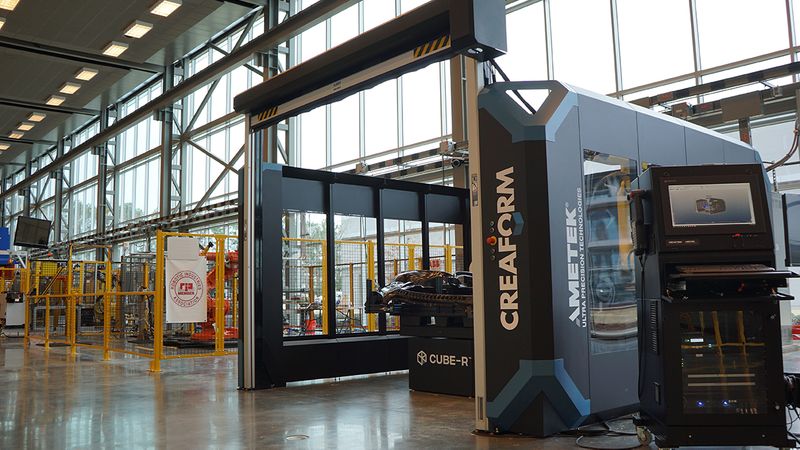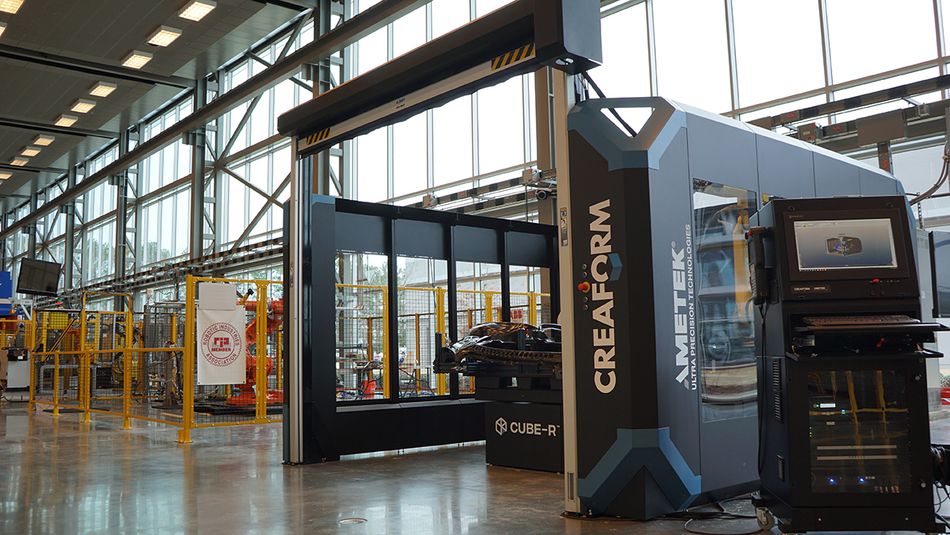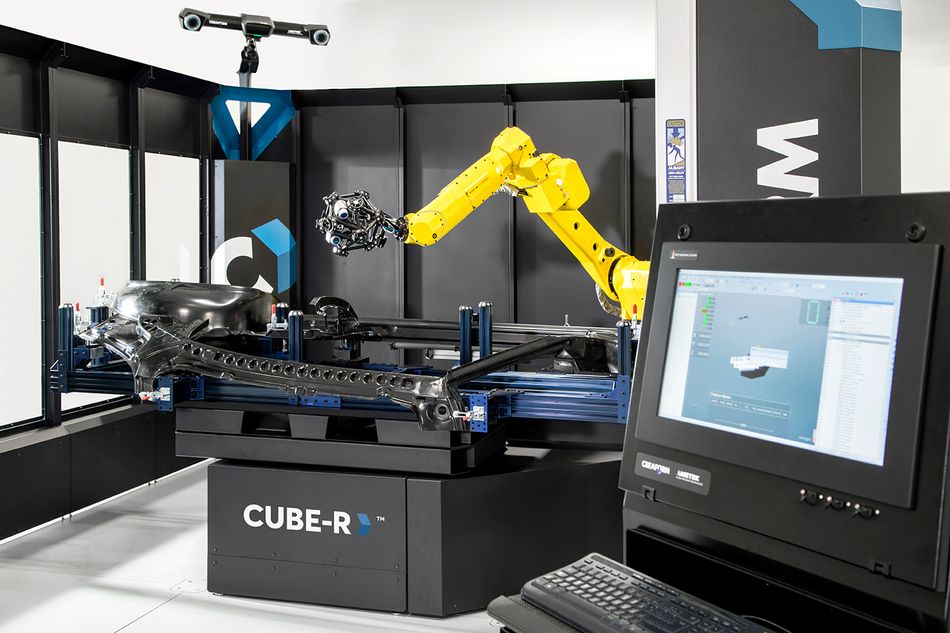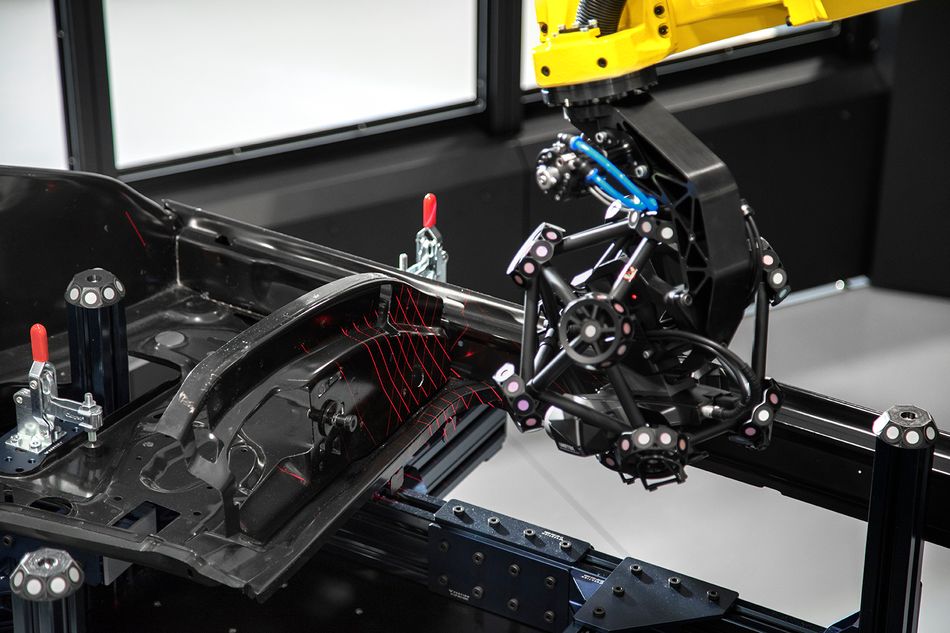Robots Are Invited To Quality Control: How To Tie In Metrology With Robotics?
The optimization of manufacturing processes has become a priority for the vast majority of the automotive and aerospace industries.

Manufacturing companies can increase productivity with robots.
This article was first published on
www.creaform3d.comThe optimization of manufacturing processes has become a priority for the vast majority of the automotive and aerospace industries. The parts designed, developed, and produced today are becoming more complex, requiring more advanced and extensive inspections with more accurate and reliable measurements.
Because plans are no longer simple and angles are no longer simply right, more points must be controlled and more data are needed for the inspection. These numerous data are obtained by measuring many parts, and these numerous acquisitions are obtained by carrying out several controls and manipulations. While such repetitive tasks, essential to the quality control of these complex assembly designs and free forms, can be carried out by human resources, there is no added value to having people perform them. Following the trend of assembly lines, robots are more than capable of executing these repetitive tasks of taking measurements and acquiring data. This way, human resources can be relocated to other responsibilities that require their contribution of skills and knowledge.
Robots are there to replace tasks, not people.
In the current context of lack of manpower and limited working time, robots offer a valuable solution because they can be used to complete certain repetitive tasks, freeing up human resources for work that adds value. This solution proved to be effective on the assembly line, and it can be applied to quality control in the same way in order to increase productivity.
Robots for Non-Experts in Robotics
But how can a company integrate robots to quality controls without having any expertise in robotics? How can a metrology specialist, who has always managed a team of operators, add robots into his or her control process without affecting the quality of inspections? Is the knowledge gap alone an obstacle to this change in procedure? Where should one start? How can the inspection process best be optimized knowing that the geometry of parts is now more complex than ever before?
For many experts in quality control, robotics is synonymous with unknown. This is the avenue that we prefer to avoid in order to stay in the comfort zone that we know so well. The metrology lab is, after all, a controlled environment where inspections can be done without difficulties. The CMM is also the most accurate metrology instrument for measuring parts with the tightest tolerances. Leaving the CMM and the metrology lab to practice quality controls directly on the production line with robots may seem like a distant vision. Thus, the first step to get there is to revisit our definition of uncertainty.
Accuracy in the Context of Manufacturing
Quality control will always mean accuracy. In the best of all worlds, each of the dimensions on each of the parts would be measured with an accuracy on the order of the smallest micron.
However, such a strategy would have a major impact on productivity. The pressure to produce, ship, and bill parts as quickly as possible is strong. In this context, are such tight tolerances on every entity absolutely necessary?
Various processes at work in the manufacturing of parts generate phenomena that are complex and difficult to predict. Spring backs appear when stamping a dye, shrinkage emerges when building a part made of composite material from a mold, and thermal forces occur when welding two elements together. These phenomena represent real puzzles that cannot be ignored. As a result, manufacturing parts with accuracies of a few tens of microns becomes practically impossible.
These phenomena that dominate the manufacturing process mean that the tolerances are more on the order of 500-750μm, see 1-1.5mm in surface profiles. Therefore, is the need to rely on a measuring instrument on the order of the smallest micron really necessary? Can the need for tight tolerances on every entity be nuanced to gain productivity?
The second step to integrating robots into the inspection process, knowing that metrologists are not experts in robotics, is to opt for turnkey solutions.
Turnkey Automated Inspection Solutions
The best option for the non-experts in robotics who want to use robots to increase productivity is to go with a turnkey automated quality control solution. This type of solution, already packaged, offers a large number of advantages such as accessibility, flexibility, and simplicity.

Accessibility
Implementing robotic cells in production usually involves three phases: design, deployment, and operation. Turnkey solutions enable metrologists to skip the first two steps, as the cell has already been developed and is ready to be deployed. This way, they can start using the inspection solution more easily and quickly. In addition to saving time, there is also money savings, because the company does not have to pay for the design and integration phases.
Moreover, turnkey automated inspection solutions have been designed with the needs of non-experts in mind. Therefore, they are easily and quickly accessible. They are also optimized for repetitive tasks in order to increase the productivity of manufacturing processes while offering the best accuracy in an industrial context. The Creaform CUBE-R is an excellent example of such a turnkey solution.
CUBE-R
The Creaform CUBE-R is an accurate turnkey 3D scanning CMM. This solution consists of a MetraSCAN 3D-R—a powerful robot-mounted optical 3D scanner—and an enclosure ready to be installed in the manufacturing process, directly at the production line. Its interface is easy to use, maximizing automatic inspections and minimizing interactions with the operator. Its design is robust, adapted to industrial environments, and optimized for inspections on the production floor.
By comparing a machine such as the CUBE-R—made of a robot and a scanner—with a traditional machine made of a CMM and a touch probe, it is clear that the first allows for an increase in productivity without a loss in accuracy and volumetric precision. Quality control managers, who are non-experts in robotics, will be able to use a turnkey solution to optimize the repetitive tasks for which human contribution does not offer added value. Thus, they will be able to relocate these human resources to more important tasks.
Flexibility
The productivity needs of manufacturing companies differ by industry. In aerospace, the volume of parts is low, while the variability and mix of models are high. In automotive, it is the opposite; the volume of parts is high, while the variability and mix of models are low. Thus, the quality control solution must be flexible because the parts to inspect are likely to change a lot. Moreover, the scanning solution must be flexible enough to digitize any type of finish, regardless of complexity, without surface preparation.
Simplicity
However, such a need for flexibility requires ease in programming. A 3D software platform such as VXelementsTM combines all of the essential tools needed for data acquisition into a sleek, simplified, and user-friendly interface. This integral part of the turnkey solution combines real-time visualization capabilities with real-time performance indicators and a simple, yet efficient, 3D scanning experience. Thus, the 3D software suite combined with the turnkey aspect of the automated solution makes the quality control equipment even easier to use.
Productivity Gain
| With turnkey automated quality control solutions like the CUBE-R, manufacturing companies can increase productivity. The productivity gain makes it possible to:
|

In short, a turnkey automated inspection solution such as the CUBE-R offers the best of both worlds: Productivity and Accuracy. Above all, the CUBE-R is an accessible, flexible, and simple measurement tool that gives control quality people access to robotics.
By incorporating robotics into quality control, the benefits are significant. The increase in productivity is certainly the most important, allowing for more dimensions and more parts to be inspected in less time. In addition, it frees up human resources to analyze the data obtained in order to take preventive actions.
Data Processing for Corrective and Preventive Actions
Automated quality control solutions make metrology accessible so that people who do these repetitive tasks today can concentrate on doing more value-added tasks. Among the most important tasks to enhance the quality of the parts is to analyze the collected data in order to take corrective and preventive actions to optimize production and avoid costly mistakes.
Indeed, there is no point in measuring a large amount of information if it is not processed and used to apply corrective or, better, preventive methods. All of the data must serve as input to production. They must be used to trigger alarms if an error occurs in production settings. They must raise red flags as soon as or, even better, before a failure arises in the manufacturing process.
Implementing corrective and preventive actions, of course, represents a huge challenge, but this is where smart manufacturing and industry 4.0 are heading. To do this, there must be a software innovation. Such a vision requires a simple-to-use software platform that can analyze alarms and immediately communicate notifications to the right department. For example, after processing inspection data, an inspection robot that detects a welding problem can send a command to the welding robot to correct this error and ensure that it does not happen again.
The ultimate goal is obviously to inspect 100% of the dimensions on 100% of the parts and to arrive at producing perfect parts, without defects. To do so, quality controls must be integrated directly into the production line.
Inline Metrology & Lean Manufacturing
Robotics is already present on the production line. However, metrology is still looking to find its way to the production floor. Thus, one of the major future developments of quality control in manufacturing will be through inline metrology.
Since it is inevitable that quality control will be implemented in industrial environments, where vibrations, dust, and changes in temperature and humidity prevail, measuring tools designed for direct use in the manufacturing process on the production line will be required. To do this, manufacturers of inspection instruments must provide people who are not metrologists with appropriate quality control solutions. At the same time, it is also necessary to make robots accessible to metrologists (i.e., non-experts in robotics) with plug-and-play, out-of-the-box solutions that don’t require a detailed user manual or a long training. Consequently, non-experts in robotics will see the robot as a collaborative element that is not only essential to quality control, but is also part of a lean production model, where the entire manufacturing process is optimized to minimize losses.
Moreover, quality control cannot neglect the importance of accuracy even if redirected on the production line. Indeed, although metrology tools are subject to the conditions of industrial and harsh environments or may be moved from one location to another, they must remain at the same level of measurement accuracy and tolerances as their counterparts used in the metrology laboratory.
Conclusion
The alliance between metrology and robotics is set to grow. Robotics can increase productivity by relocating human resources to value-added tasks and increasing the number of parts and/or dimensions measured, with the ultimate goal of controlling the quality of 100% of dimensions on 100% of parts.
Automated quality control solutions will make inline metrology even more accessible, flexible, and simple to use without ever neglecting the importance of accuracy in industrial conditions and manufacturing environments. This development will be supported by a software architecture that provides clear and fast results in a format that supports preventive and corrective actions.
This innovation requires hardware and software, which will connect lean manufacturing and inline metrology via a platform where it is impossible to misuse a metrology equipment mounted on a robot and attached to